It took me many years of reading, researching, & writing to eventually get this book published in 2019. I wanted to achieve two main aims with the book. The first was providing to a broader audience the theory of “the Axial Age” which has become an intensively studied area by a great variety of specialized scholarship. Second, to offer my own scholarly contribution, which is an alternative emphasis on what the Axial Age is about.
The theory of the Axial Age in its influential form was developed by German philosopher Karl Jaspers shortly after World War II. Jaspers perceived the war as perhaps the first truly global event to have occurred in human history, something enabled by modern technology and, equally notable, an extraordinarily violent and destructive event. Therefore he argued we need to try to get some perspective and gain our bearings on world history. He proposed the time period of 800-200 BCE as decisive for setting world history on its course. He conceives the decisiveness as an axis, a dividing line within history that creates a distinctive “before” and “after” that are significantly different. Within those several centuries, philosophers in Greece, prophets in Israel and the ancient Near East, holy men in India, and sages in China, provide a revolutionary set of ideas, beliefs, and practices that take root and spread and go on to become the basis for the worldviews of entire civilizations (like Europe, or China) and of “world religions” (like Buddhism, or Taoism). Jaspers argued that what was revolutionary in all of these movements was their conception of reality as having a transcendent dimension, a conception that was lacking in earlier thought.
Scholars on the Axial Age have either emphasized the idea of transcendence as what is key and how these become the worldviews of historical civilizations, or the emergence of world religions as complex belief systems. The first emphasis is cognitive & intellectual while the second is sociological & institutional. While I don’t think these emphases are wrong, they do miss out on what I argue is distinctive: which is that the Axial Age visionaries themselves emphasized practical spirituality (not ideas about spiritual reality) and that they themselves formed very small communities on the margins of civilization (not replacing existing “big religions” with new “big religions”). True, two potential outcomes of sustained spiritual practice are a transformation of consciousness (and thus, you think differently and gain different ideas about reality) as well as inspiring a new way of being religious (and thus, you could develop a new religion). But do these outcomes fit with what was originally practiced and envisioned? Or is it possible they mis-take the original practice and vision? (I argue the latter.)
To provide a very brief, succinct summary of what the “spiritual virtuosi” of the Axial Age practiced, here is the summary in 4 points:
- they are critical of civilization, above all, of how its power manifests: in becoming powerful we become arrogant, unjust, and destructive; power tempts us into inhumane, unethical, and unspiritual potentials
- the criticism is intellectual and philosophical, among other things, but its primary force is embodied in how they live: invariably, they form small communities located on the margins of civilizational power – on the outskirts of town, in the forest, in the desert or on a mountain. Or in some cases, they take up a traveling life. So rejecting the temptations of civilization’s power is built into their way of life, and into the small and local scale of living that is practiced. (Note that in moving away from civilization – the city, the temple, the palace, the marketplace – they also invariably move into the wilderness; and in this regard, there is a potent ecological resource built into Axial Age spirituality.)
- the criticism is also practical: at the center of community living is sustained, systematic, meditative practice. Undertaking this practice over a long period of time brings into critical conscious awareness the depth and extent of civilizational power in constructing your identity and how you think and feel; the systematic practice of meditation uncovers and deconstructs that power
- the ultimate aim of living in small community and undertaking spiritual practices is to overcome the power of the ego and transform one’s self. Unlike civilizational power, which is turned outward in ultimately destructive ways upon the earth, the spiritual power of meditative practice is turned inward, upon one’s own consciousness. While this proves ultimately destructive to the ego, egocentric consciousness, and the egocentric self, since this is a destruction of an illusion relative to a higher, deeper truth, the outcome is an enlightenment, an awakening, a transfiguration.

Practicing Transcendence
Axial Age Spiritualities for a World in Crisis
© 2019
Author: Peet, Christopher
This book introduces readers to the concept of the Axial Age and its relevance for a world in crisis. Scholars have become increasingly interested in philosopher Karl Jaspers’ thesis that a spiritual revolution in consciousness during the first millennium BCE decisively shaped world history. Axial ideas of transcendence develop into ideologies for world religions and civilizations, in turn coalescing into a Eurasian world-system that spreads globally to become the foundation of our contemporary world. Alongside ideas and ideologies, the Axial Age also taught spiritual practices critically resisting the new scale of civilizational power: in small counter-cultural communities on the margins of society, they turn our conscious focus inward to transform ourselves and overcome the destructive potentials within human nature. Axial spiritualities offer humanity a practical wisdom, a profound psychology, and deep hope: to transform despair into resilience, helping us face with courage the ecological and political challenges confronting us today.
Amazon | Palgrave | Chapters | Google Books | Walmart

